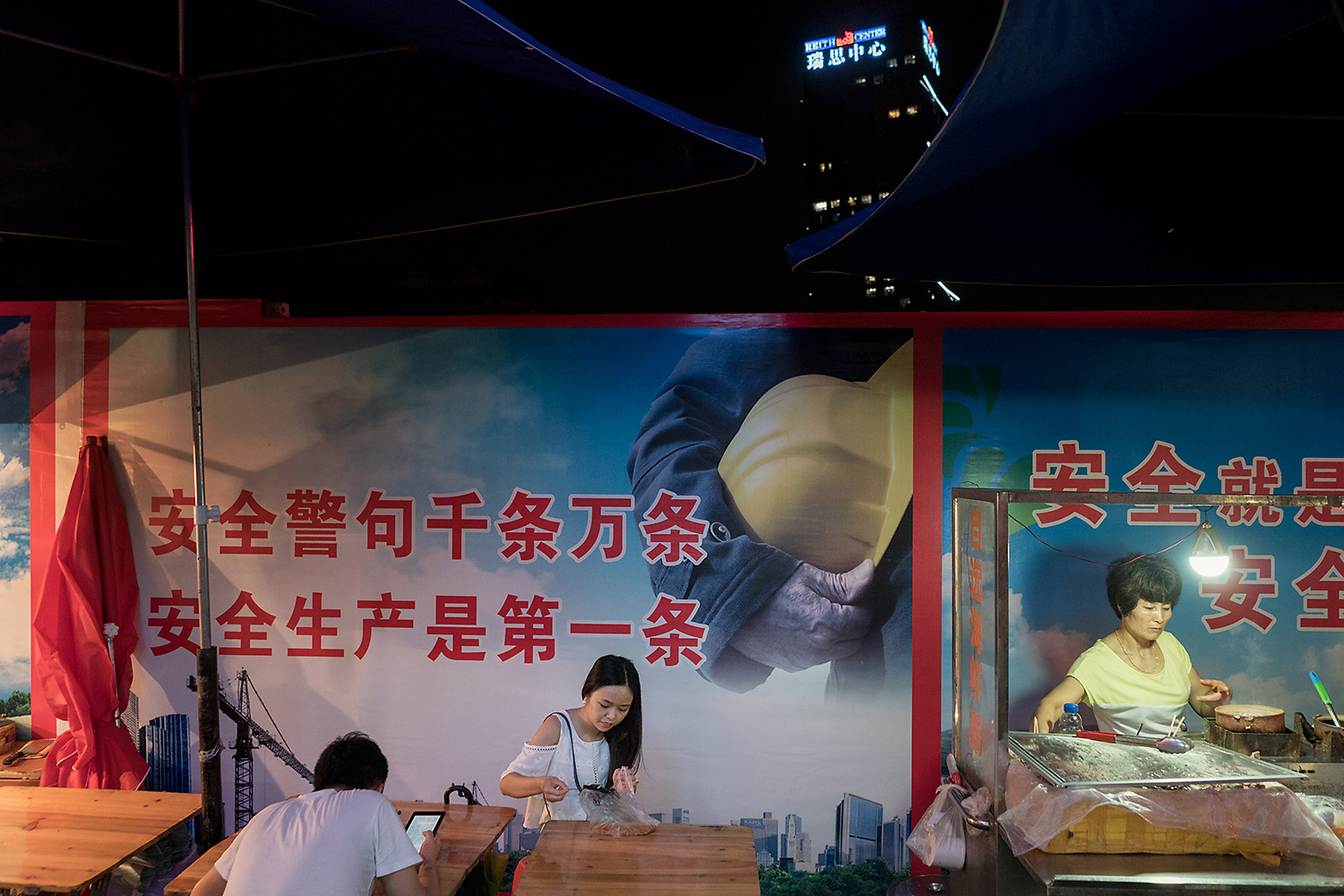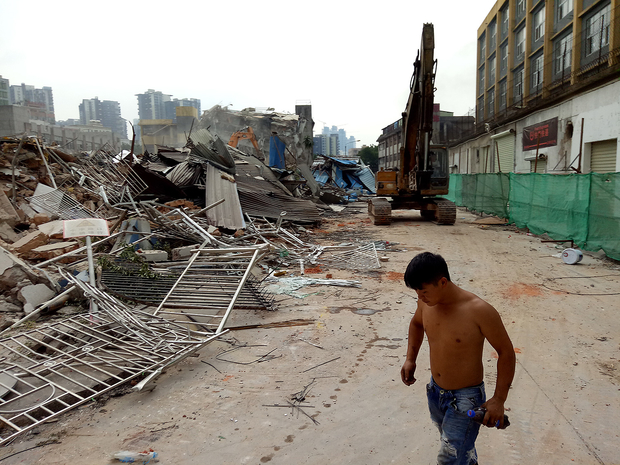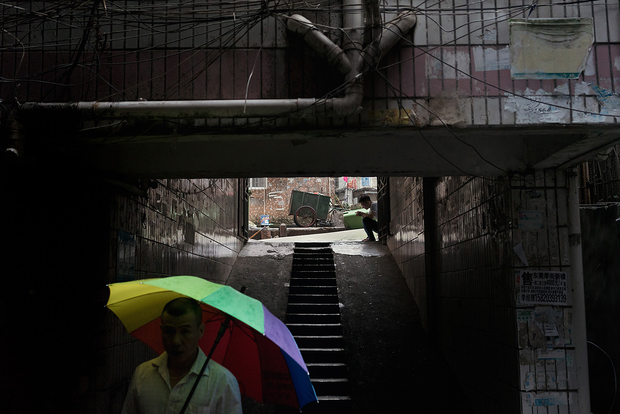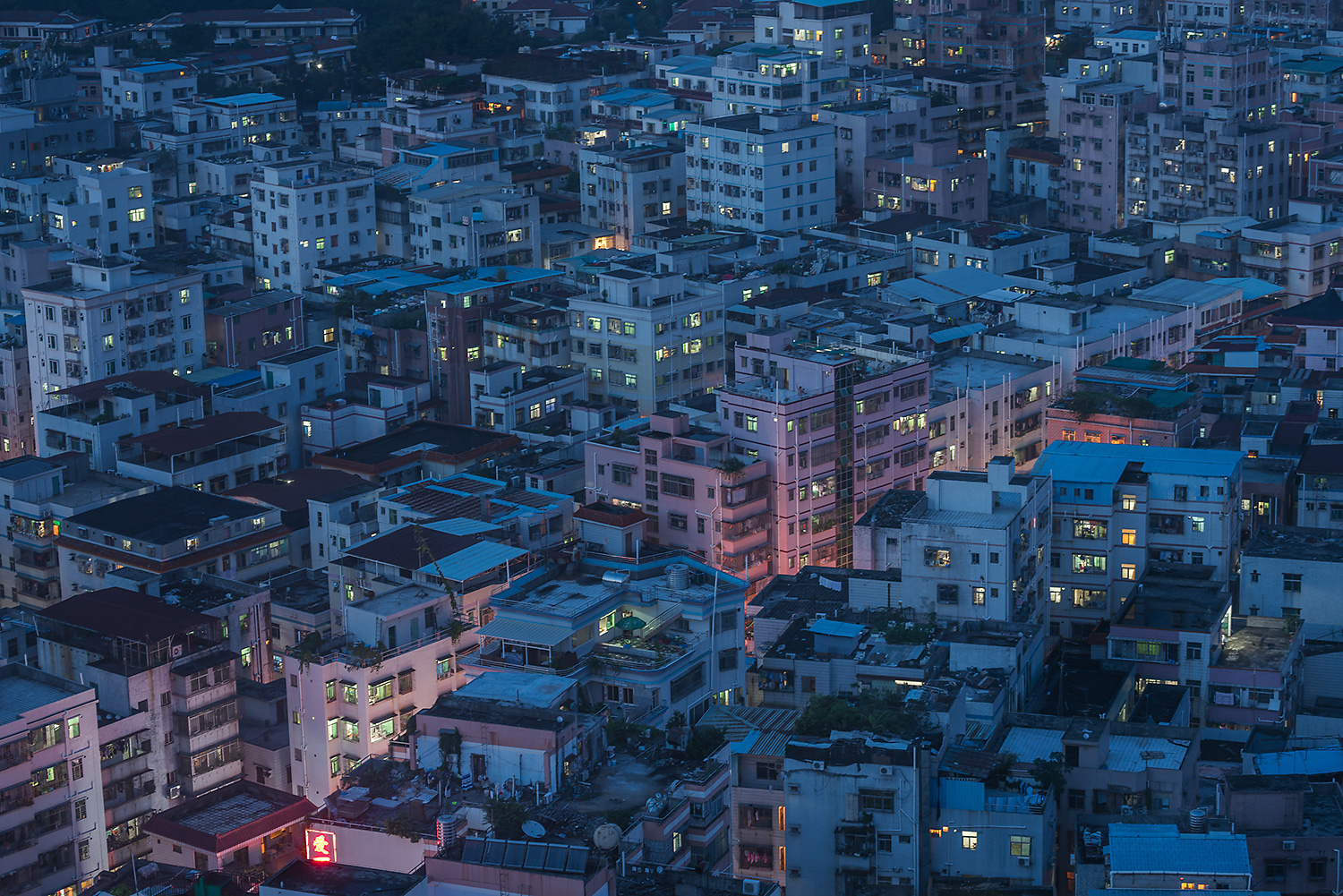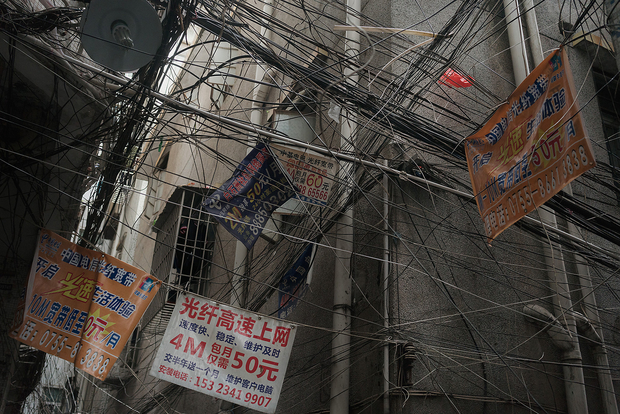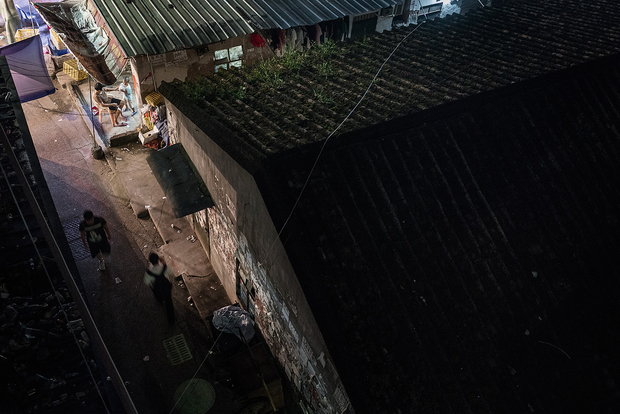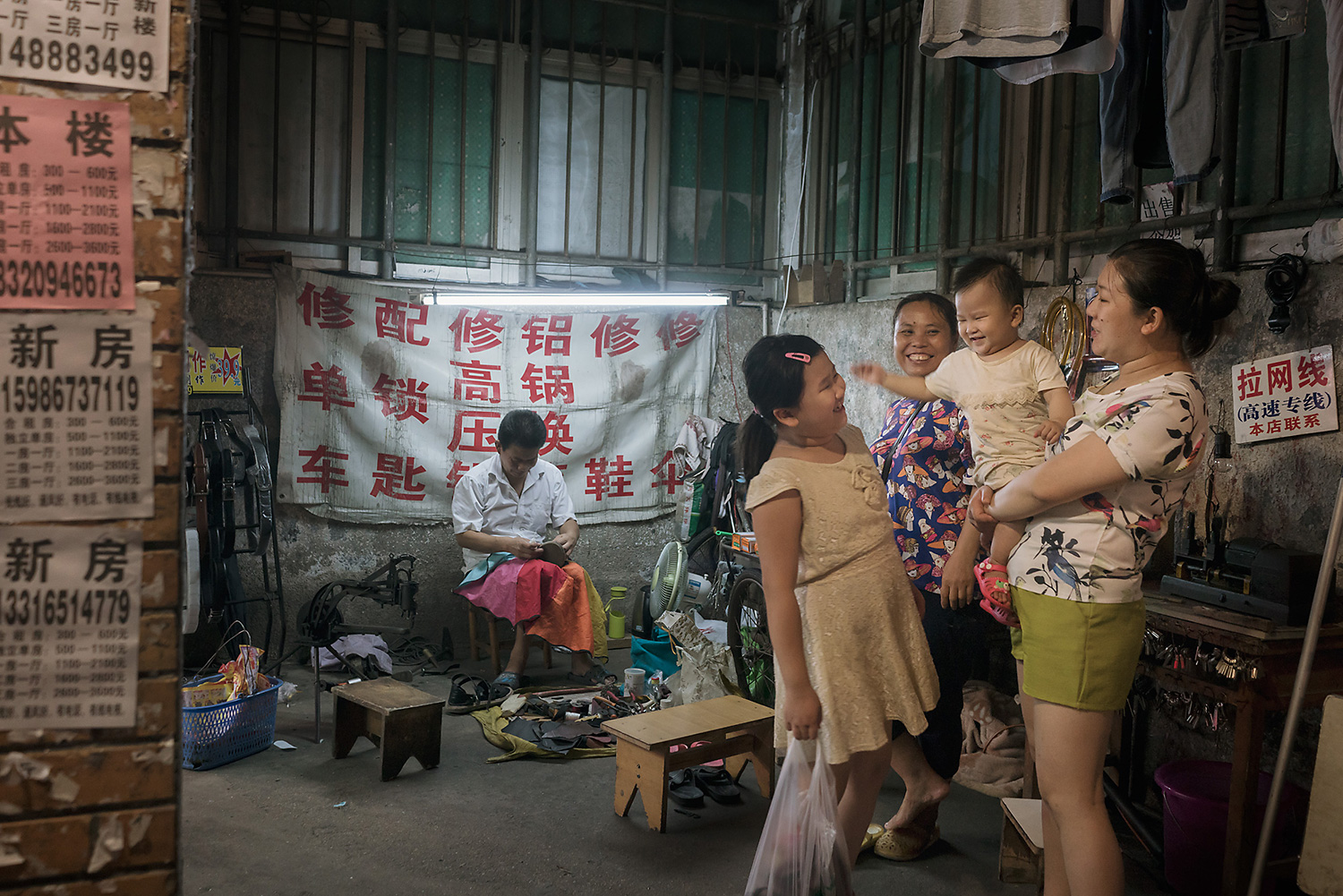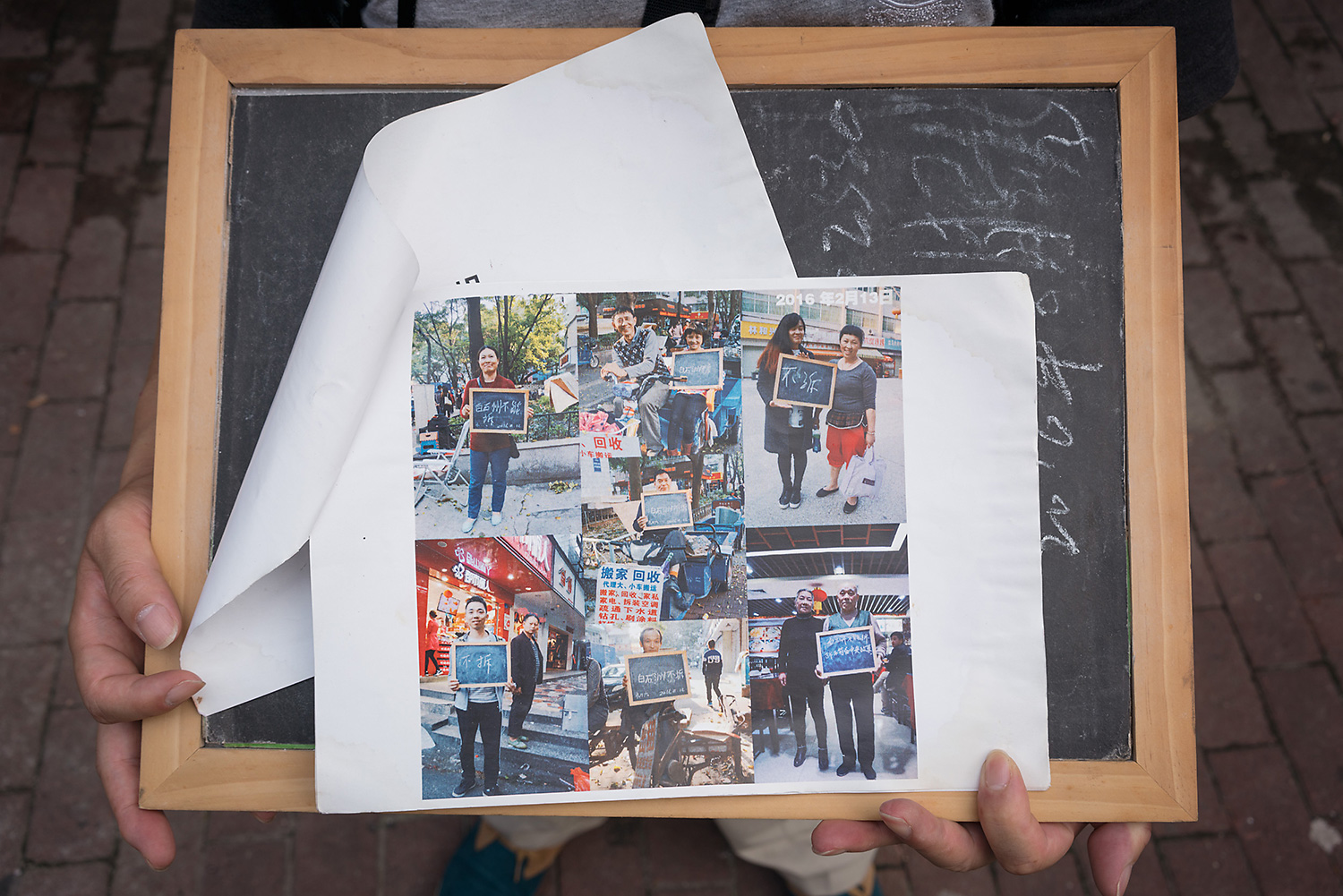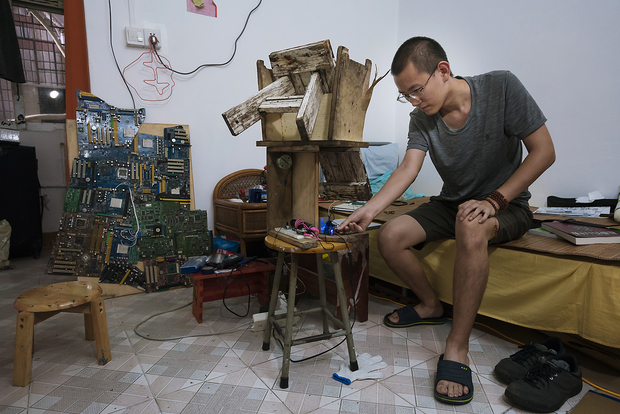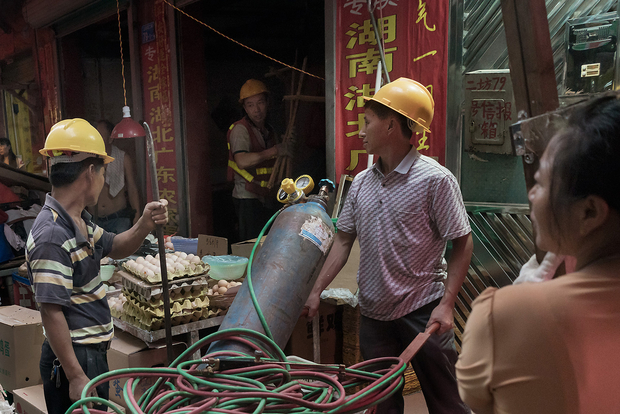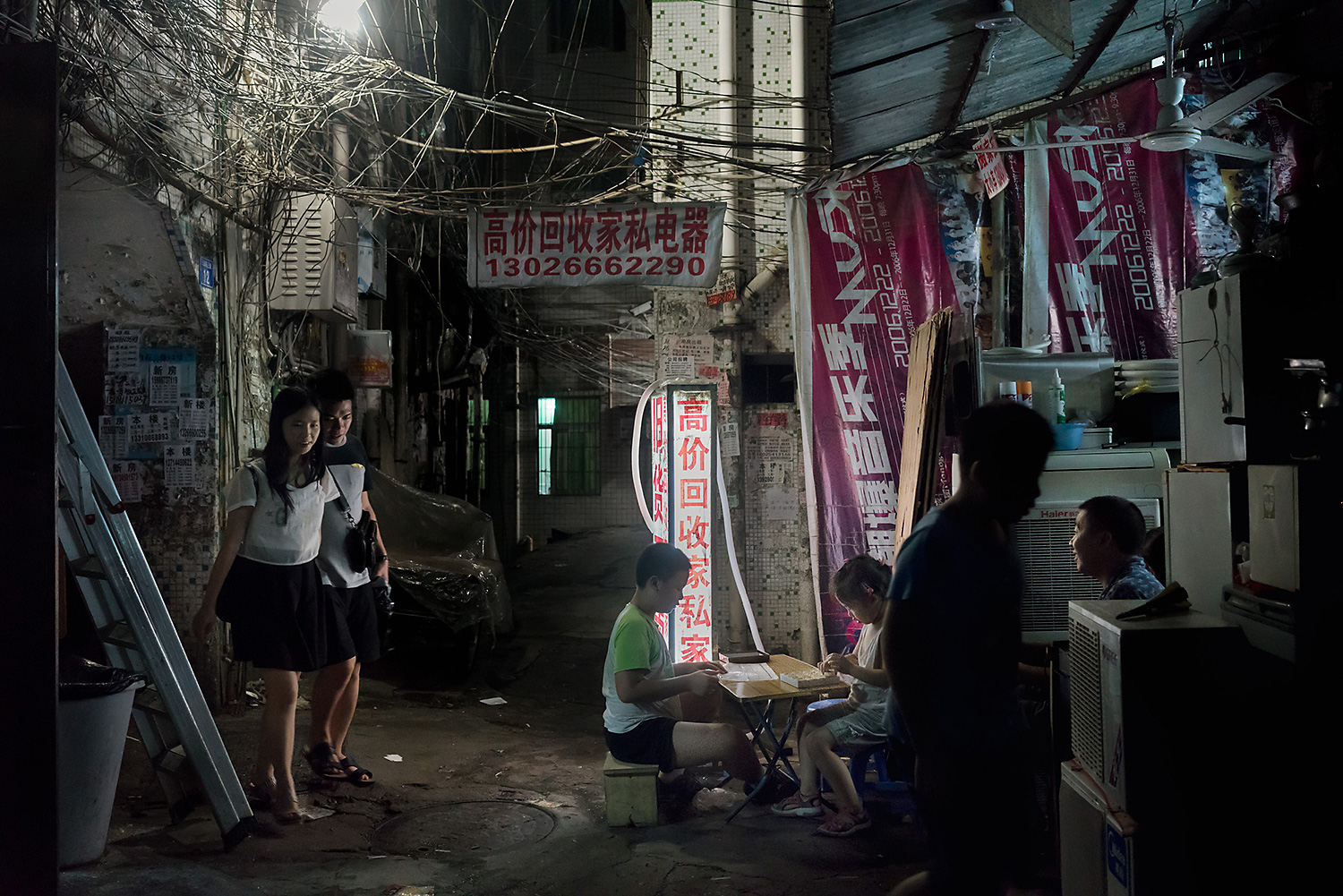Early this spring, the Chinese character for “demolish” (“拆”) showed up in red spray paint on a strip of shops in Shenzhen’s Baishizhou neighborhood. Wang An, 41, has been selling women’s underwear from one of these shops for the last 10 years. “When they knock it down, I guess we’ll just go home to Hubei [province] and grow vegetables,” he joked in April. The spray paint marked Wang’s shop as one of the buildings scheduled to be torn down in the first phase of Baishizhou’s renewal. He responded to the news with a buy-one-get-free sale that continued through the summer.
On August 31, he received notice that his power would be cut in a week. The next day, the demolition of a swathe of buildings behind his shop began. With his shop closing in a few days, he still wasn’t sure what he and his wife would do next. Brick-and-mortar underwear stores can’t compete with ecommerce, he said, so, after taking some time to look for new opportunities, they’ll decide whether to leave Shenzhen.
The planned destruction of Baishizhou will impact its roughly 150,000 residents, many of them recent migrants looking for a new life in one of China’s most prosperous cities. But it also stands to erase a neighborhood whose dynamism rivals that of any in the world. Baishizhou is a labyrinthine dream on 0.23 square miles of mixed-use residential space, with a population density more than 20 times the city average.
Start with Cannery Row, then jerry-rig it to accommodate half the population of Iceland, and you’re close to Baishizhou. A tangle of damp alleyways opens at odd intervals onto wider avenues of frenzied commerce—fruit carts, shoe repair, blind massage, hot pot, pig’s feet on rice, coal-roasted sweet potato, fortune tellers, handymen for hire, smartphone engravers, karaoke parlors, smoke shops, love hotels, furniture dealers, street-side lamb butchers, elementary schools, mahjong rooms, communal laundry wells, open-air billiard halls, and a vast number of hair salons where customers can get a head massage, a cut, and a wash for about four dollars. All of it hustles by under a sun-blocking canopy of braided telephone wires.
Shenzhen’s government has slated Baishizhou for renewal, and the current proposal from Hong Kong-based developer LVGEM aims to replace it with 59.2 million square feet of high-rises, malls, and hotels, along with a skyscraper billed as a new icon for the district. LVGEM posters explain the importance of the surveying work that’s underway to sort out who exactly has an ownership stake in Baishizhou’s cramped apartment buildings, in advance of the coming buyout.
Baishizhou also includes a densely built industrial area that’s populated with small- and medium-sized businesses—from kitchen-supply companies to surface-mount technology workshops—and skirted with shops and restaurants. Another developer, the state-owned Shum Yip, has begun tearing down buildings to construct an up-market housing development. Plans for this area, which houses Wang’s underwear store, moved forward quickly because, unlike most of the neighborhood, a state-owned enterprise has long owned it.
Wang says he never signed a contract in his 10 years in the location; he compared his informal rental agreement with one you might make when borrowing a phone from a friend who can decide at any time that she’d like to take it back. This type of agreement is typical of Baishizhou’s renters, who are estimated to make up more than 90 percent of the neighborhood’s residents, and who have no claim to compensation when the renewal begins.
Many of the renters interviewed for this story see Baishizhou’s demise as manifest destiny, an inevitable part of Shenzhen’s story of unbridled development. But there’s a widespread view among them that the obstacles remaining for a large-scale renewal, both financial and human, are enormous. Meanwhile, Baishizhou properties grow more valuable, new businesses open, the children of renters enroll in local schools, property owners continue to upgrade their investments against an eventual buyout, and the promise of a monumental hassle looms larger.
“Nobody knows when it’s going to happen. I came here five years ago, and they said they were going to knock it down in three years,” said Hong Xiaohui, who runs a stewed duck restaurant called Shaxian Snacks in Baishizhou, on the same street as an apartment that she shares with her husband, mother-in-law, and young daughter. “Everyone says something different. There are people who say it’s just about to happen, and those who say it’ll be three, four, five years from now. But even the landlords don’t know, so how could we know?”
* * *
Shenzhen, the southern megacity separated by a river from Hong Kong, was the guinea pig for the economic reforms of the 1980s that led to China’s fantastic growth. The experiment also propelled what was once a scattered group of rural communities to become one of the wealthiest cities in the country: Its GDP per capita grew to roughly U.S.$25,000 in 2015—from under U.S.$100 in 1979, when the boundaries of the new Shenzhen municipality were first drawn. And it’s one of China’s largest cities, as well. Growing from a population of roughly 300,000 in 1979 to an estimated 18 million today, Shenzhen broke the 10-million mark to become a megacity faster than any other place in history.
The Shenzhen of 2016, with its sweeping eight-lane boulevards and its kaleidoscopic expanses of indistinguishable pastel apartment blocks, looks mostly like what one would expect of a city that sprang up from nothing just 36 years ago. It’s the kind of urban landscape that arises as a flood of money rolls in unexpectedly and then doesn’t stop.
But there are irregularities in the sprawl, and millions of Shenzhen’s inhabitants live in them. These are the chengzhongcun, literally “villages in the middle of the city,” often translated as “urban villages.” These “villages” usually take the form of a huddled warren of nine- and 10-story “handshake buildings”—so called because they’re built so close together that residents can stick an arm out the window for a handshake with a neighbor. The buildings’ lack of elevators limit their heights, and, when seen from above, urban villages look like stunted patches on the greater cityscape, undergrowth in a forest of high-rises.
But the chengzhongcun scattered throughout the city have somehow resisted the deluge of bland modernization that has overtaken their surroundings. “When I walked into Baishizhou for the first time, it brought me back to childhood,” said Duan Peng, 44, a local architect who has researched the city’s urban villages. “The little streets and alleys, the humanity of the place.”
“Village” may not seem like the right term for a cluster of tenement-style walkups that can house more than 100,000 people. Chengzhongcun hang onto the name partly because of the familiarity evoked by the traditions and small-scale businesses that thrive among their migrant populations, and partly because when modern Shenzhen began growing, these places really were just villages in the middle of the city.
In the late 1970s, when Beijing undertook plans to turn Shenzhen into the country’s first Special Economic Zone—an experimental area with more liberal financial policies—the government first had to purchase land from the local villagers living there, mostly farmers and fishermen, and convert it to municipal property. Officials took the path of least resistance, buying up farmland and leaving the actual villages untouched. This left villagers with lump sums of cash but extinguished the basis for their agricultural lifestyle, and essentially set them adrift in a rising sea of construction projects. Crucially, though, their homes were still designated as rural land. Although they were living at ground zero for Shenzhen’s big bang of urbanization, they still held onto special home ownership rights, giving them a degree of freedom in deciding what to do with their pockets of the city.
In other words, they were in a fine position to participate in Shenzhen’s capitalist experiment. As waves of migrant workers flowed into the city to fuel the manufacturing boom, the villagers put their money into maximizing rental space: building residential buildings that went as high as tenants were willing to climb, and then partitioning them into ever smaller units and crowding them closer and closer together. In the process, they gave Shenzhen a backbone of affordable, albeit poorly regulated, housing that was vital to the city’s rise.
This is the basic origin story of Shenzhen’s urban villages, and Baishizhou’s cheek-to-cheek walkups were built in the same spirit. But Baishizhou stands out among the city’s chengzhongcun for its sprawling size—something it owes to an earlier brush with history.
The neighborhood that is today called Baishizhou is actually a group of five historical villages. Their boundaries blurred after they were absorbed into a Mao-era collective farm established in the area in 1958. (A row of long, tile-roofed dormitories built at the time—now surrounded on all sides by hand-shake housing and open-air barbecue tents—are one of Baishizhou’s most distinctive features.) When the collective farm gave way to state-owned enterprises in the 1980s, villagers held onto housing ownership rights, and it is they, as well as those who bought into Baishizhou’s later construction, that stand to profit off of compensation for the redevelopment.
Shenzhen’s residential housing prices experienced the fastest growth of any major city in the world in 2015, rising by nearly 50 percent from the year before. And urban villages, thanks to their peculiar origins, are often located on extra-prime real estate. Baishizhou is at the heart of Nanshan District, not far from the thriving technology park that houses homegrown giants like Tencent and DJI. It straddles Shennan Avenue, one of the city’s main thoroughfares, at a locus of bus and subway transportation that swarms in the morning with everyone from factory workers to freshly graduated software developers.
The surrounding area is a testament to Baishizhou’s total inability to take a hint. There are three separate amusement parks, a golf course, a gated community modeled on the Italian Riviera, and a flourishing, but expensive, neighborhood of parks, malls, and creative industry. “From a business perspective, redeveloping Baishizhou is obvious,” said Jet Cui, 30, a tech startup founder who grew up in the neighborhood. “From the government perspective, it’s Shennan Avenue. We call it ‘the namecard of Shenzhen,’ because on either side of the road it’s all famous companies, famous buildings. But then there’s Baishizhou, and it’s a kind of black dot.”
In Baishizhou, a room big enough for a married couple can be rented for between 1,300 and 2,000 yuan a month (roughly U.S.$200-300). A basic space in a mid-range apartment complex just outside the village might cost three times that. Small-business owners, along with industrial workers, are key constituents in Baishizhou’s population. But the area is also increasingly home to the young professionals driving a government effort to transform Shenzhen from the world’s factory into a hub for technology, innovation, and design, helping it live up to its nickname: “China’s Silicon Valley.”
“If Shenzhen loses its affordable housing, the whole chain will break,” the architect Duan said. “The industrial sector will hollow out, and for most of our startups, our design companies, and our tech companies, the cost of labor will go up, because almost all of their young workers live in the urban villages.”
At a time when startup incubators are cropping up all over Shenzhen, Baishizhou hangs on to a reputation as a talent incubator for the city itself—the inevitable landing pad for hungry new arrivals. As Cui sources parts for a pair of Bluetooth headphones he’s developing to pair with the new iPhone, he says he often bonds with executives over Baishizhou origin stories.
“If you ask any boss or a guy in a high-up place now, they’ll tell you they got their start here, that it was the first place they lived in Shenzhen,” he said. “They paid 500 yuan (U.S.$77) to stay for a month, and the rest was for living expenses. It was a start, and without that, they’d have nothing now.”
Still, Cui sees Baishizhou’s redevelopment as a foregone conclusion, and he says his parents, who own their apartment, are going to be overjoyed when the time comes to sell. Previous redevelopments of urban villages in Shenzhen, such as Nanshan’s Dachong village, are legendary for instantaneously making multimillionaires of original owners with favorable holdings, though rumors also fly of the ill treatment received by owners who held out against a buyout.
* * *
Before Baishizhou is razed, Duan wants the voices of its residents to be heard. On Saturday afternoons, he walks around the neighborhood and photographs residents and local business owners holding a small blackboard. On it, they chalk their names and a simple two-character message, “buchai,” meaning “don’t demolish.”
“During past urban village redevelopments, they’ve paid attention to the interests of the developer, of the government, of the original residents, but no one has ever paid attention to the interests of the renters,” said Duan. “And to some extent, these renters are the real owners of the urban villages. They have made huge contributions to Shenzhen and the urban villages, but if the government says raze, then the village is razed, and if the government says get out, then the people have to get out.”
Duan is gathering names for a petition as he goes on his photo walks, which he plans to submit to the city government along with the portraits of residents. He’s very often rejected or outright ignored, as modern China has little social precedent for what he’s doing, but he usually gets four or five signatures a trip. “It’s not about making the government look bad, it’s about communicating with them so that they understand the whole situation,” he said. “We’re not against the improvement of the urban village, but we’re against this totally destructive method of throwing out everything to rebuild.”
On a trip to Baishizhou in late April, Duan approached a man and woman walking home from a market with their young daughter. The man, a 31-year-old software developer who asked to be referred to only by his last name, Wu, had lived in Baishizhou for three years. He said he’d already seen two of his previous neighborhoods in Shenzhen demolished.
The family agreed to be photographed, and afterward Wu asked if he could join Duan for the rest of the evening to help with the project. He dropped his family off at their home in a nearby handshake building and came back down carrying a second blackboard.
There are other signs that Duan’s efforts aren’t in vain. Earlier this summer, he joined a chorus of voices, including local designers, architects, and artists, opposing the planned redevelopment of another one of Shenzhen’s urban villages, Hubei. The issue caught the attention of the local media, in part because of the village’s easy-to-see historical value: Hubei, whose roots stretch back to 1466, has narrow lanes laid out in an eight-by-three grid typical of ancient Cantonese villages, and rows of squat, tile-roofed houses that marshal behind a well-used ancestral hall.
As with Baishizhou, it was set to make way for shopping centers and apartment complexes. But the outcry carried. Plans to redevelop the historic core of the village were canceled (though the redevelopment of the area surrounding the old village will go forward). In August, the city government shared a draft of new guidelines for urban renewal efforts, with sections that seemed to allude to Hubei. Along with making special allowances for urban villages with special historical value, the guidelines also broadly recommend that future renewals of chengzhongcun use renovations and quality-of-life improvements as a first approach, over whole-sale demolitions.
Whether the proposed new guidelines will impact Baishizhou’s future remains to be seen. Buildings are already coming down in the neighborhood’s industrial area. But a policy shift could change the dynamic in negotiations over the rest of Baishizhou.
Meanwhile, the electricity at Wang’s store has been cut. On September 10, he and his wife were still there, trying to sell off the last of their stock from a darkened store, while workers around the corner tossed debris out of gutted buildings.




